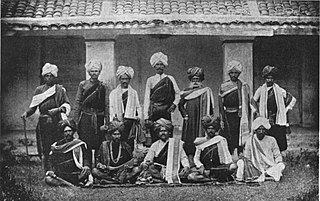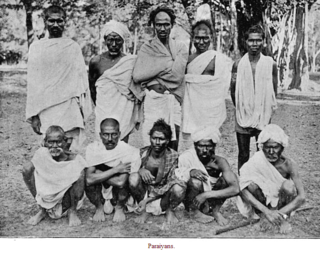Related Research Articles

Brahmin is a varna as well as a caste within Hindu society. The other three varnas are the Kshatriya, Vaishya, and Shudra. The traditional occupation of Brahmins is that of priesthood at Hindu temples or at socio-religious ceremonies, and the performing of rite of passage rituals such as solemnising a wedding with hymns and prayers.
The Maratha caste is composed of 96 clans, originally formed in the earlier centuries from the amalgamation of families from the peasant (Kunbi), shepherd (Dhangar), blacksmith (Lohar), carpenter (Sutar), Bhandari, Thakar and Koli castes in Maharashtra. Many of them took to military service in the 16th century for the Deccan sultanates or the Mughals. Later in the 17th and 18th centuries, they served in the armies of the Maratha Empire, founded by Shivaji, a Maratha Kunbi by caste. Many Marathas were granted hereditary fiefs by the Sultanates, and Mughals for their service.

The Konkan is a stretch of land by the western coast of India, bound by the river Daman Ganga at Damaon in the north, to Anjediva Island next to Karwar town in the south; with the Arabian Sea to the west and the Deccan plateau to the east. The hinterland east of the coast has numerous river valleys, riverine islands and the hilly slopes known as the Western Ghats; that lead up into the tablelands of the Deccan. The region has been recognised by name, since at least the time of Strabo in the third century CE. It had a thriving mercantile port with Arab tradesmen from the 10th century. The best-known islands of Konkan are Ilhas de Goa, the site of the Goa state's capital at Panjim and the Seven Islands of Bombay, on which lies Mumbai, the capital of Maharashtra and the headquarters of Konkan Division.
Saraswat Brahmins are Hindu Brahmins, who are spread over widely separated regions spanning from Kashmir and Punjab in North India to Konkan in West India to Kanara and Kerala in South India. The word Saraswat is derived from the Rigvedic Sarasvati River.
Deshastha Brahmin is a Hindu Brahmin subcaste mainly from the Indian state of Maharashtra and North Karnataka. Other than these states, according to authors K. S. Singh, Gregory Naik and Pran Nath Chopra, Deshastha Brahmins are also concentrated in the states of Telangana (which was earlier part of Hyderabad State and Berar Division), Andhra Pradesh and Madhya Pradesh (Which was earlier part of Central Provinces and Berar) Historian Pran Nath Chopra and journalist Pritish Nandy say, "Most of the well-known saints from Maharashtra, Karnataka and Andhra Pradesh were Deshastha Brahmins". The mother tongue of Deshastha Brahmins is either Marathi, Kannada or Telugu.

The Chitpavan Brahmin or the Konkanastha Brahmin is a Hindu Maharashtrian Brahmin community inhabiting Konkan, the coastal region of the state of Maharashtra. Initially working as messengers and spies in the late seventeenth century, the community came into prominence during the 18th century when the heirs of Peshwa from the Bhat family of Balaji Vishwanath became the de facto rulers of the Maratha empire. Until the 18th century, the Chitpavans were held in low esteem by the Deshastha, the older established Brahmin community of Karnataka-Maharashtra region.
Karhaḍe Brahmins are a Hindu Brahmin sub-caste mainly from the Indian state of Maharashtra, but are also distributed in states of Goa, Karnataka and Madhya Pradesh.
Telugu Brahmins are Telugu-speaking Brahmin communities native to the Indian states of Andhra Pradesh and Telangana. They fall under the Pancha Dravida Brahmin classification of the Brahmin community in India. Telugu Brahmins are further divided into sections like Vaidiki, Niyogi, Deshastha, Dravida, Golkonda Vyapari among others.
Karnataka Brahmins or Carnatic Brahmins are Pancha Dravida Brahmin native to the Indian state of Karnataka.

Amāvásyā is the lunar phase of the new moon in Sanskrit. Indian calendars use 30 lunar phases, called tithi in India. The dark moon tithi is when the Moon is within 12 degrees of the angular distance between the Sun and Moon before conjunction (syzygy). The New Moon tithi is the 12 angular degrees after syzygy. Amāvásyā is often translated as new moon since there is no standard term for the Moon before conjunction in English.

Bengali Brahmins are the community of Hindu Brahmins, who traditionally reside in the Bengal region of the Indian subcontinent, currently comprising the Indian state of West Bengal and the country of Bangladesh.

Vokkaliga is a community of closely related castes, from the Indian states of Karnataka and Tamil Nadu.

Paraiyar, or Parayar or Maraiyar, is a caste group found in the Indian states of Tamil Nadu and Kerala and in Sri Lanka.
The Nayak, or Naik is a historic Indian title conferred on military generals and governors of feudal states in the Middle Ages. Today it is also a surname. Nayaks are mostly Hindu and few Sikhs, who follow Hinduism and Sikhism respectively.
Gaud Saraswat Brahmins (GSB) are a Hindu Brahmin community, who are part of the larger Saraswat Brahmin community that migrated to Konkan from Gaud, as per the Skanda Purana in ancient India. They belong to the Pancha Gauda Brahmins group. They primarily speak Konkani and its various dialects as their mother tongue.
The caste system in Goa consists of various Jātis or sub-castes found among Hindus belonging to the four varnas, as well as those outside of them. A variation of the traditional Hindu caste system was also retained by the Goan Catholic community.
Pancha Gauda is one of the two major groupings of Brahmins in Hinduism, of which the other is Pancha-Dravida.
Gaur Brahmins are a community of Brahmins in India. They are one of the five Pancha Gauda Brahmin communities that live north of the Vindhyas.
Sahyādri-khaṇḍa is a Sanskrit-language text, notable for containing the founding myths of several Brahmin communities of south-western India. The text claims to be a part of the Skanda Purana. It is actually a collection of disparate texts that date from 5th to 13th centuries, and have been organized as part of a single text relatively recently.
Kannada Brahmins are Kannada-speaking Brahmins, primarily living in Karnataka, and also present in the states of Telangana, Andhra Pradesh, Kerala, and Tamil Nadu. They belong to one of three traditions: Smartism, Sadh Vaishnavism, and Sri Vaishnavism, and are followers of Adi Shankara, Madhvacharya, and Ramanuja respectively.
References
- ↑ James G. Lochtefeld (2002). The Illustrated Encyclopedia of Hinduism: N-Z . Rosen. pp. 490–491. ISBN 9780823931804.
- ↑ D. Shyam Babu and Ravindra S. Khare, ed. (2011). Caste in Life: Experiencing Inequalities. Pearson Education India. p. 168. ISBN 9788131754399.
- ↑ Pandya, A V (1952). Abu in Bombay State: A Scientific Study of the Problem. Charutar Vidya Mandal. p. 29.
It is interesting to note here that the Brahmin groups of Marwar and Mewar belong to the Gurjara group of the Pancha Dravida division
- ↑ Rosalind O'Hanlon (2013). "Performance in a World of Paper: Puranic Histories and Social communication in Early Modern India". Past and Present. Oxford University Press / The Past and Present Society (219): 104. JSTOR 24543602.
- ↑ Deshpande, Madhav (2010). "Pañca-Gauḍa and Pañca-Drāviḍa: Contested Borders of a Traditional Classification". Studia Orientalia. 108: 34.
- 1 2 Krishnaji Nageshrao Chitnis (1994). Glimpses of Maratha Socio-economic History. Atlantic. pp. 95–96. ISBN 978-81-7156-347-0.